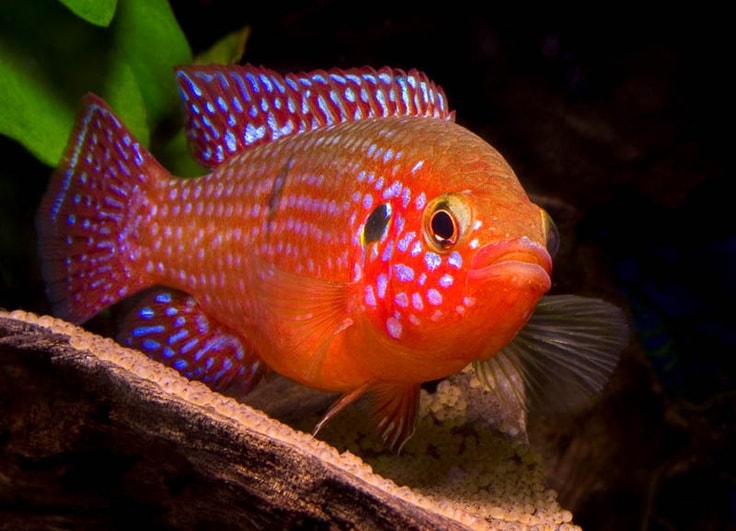In this article I will be talking about my experiences with a West African substrate spawner, the Hemichromis bimaculatus, commonly known as the Two Spotted Jewel Cichlid. Keep in mind that not all substrate spawners will partake in these exact events from one specie of fish to another. All information contained in this article is based on my experiences with the twelve separate breedings of this fish that have taken place in my home.

What they typically mean by substrate spawner is that the laying and seeding of the eggs generally takes place in the gravel on the bottom of the tank or on a rock. The H. bimaculatus generally prefer to lay their eggs on a flat rock leaning on some sort of an angle, preferably a 45ş angle. When there are no such rocks in the tank, they can and will at times dig a dugout (pit) into the gravel in a place of their liking, which is usually where they feel the eggs will be safe from other fish in the tank, or sometimes just out of sight from the keeper of the fish themselves. For an example of that, in one of my tanks right now where there is lace rock and no flat smooth rocks, they have dug a pit.
For these fish, H. bimaculatus, I keep the tank regulated to 80şF with a nice reliable submersible heater (Ebo Jager Ts-100), soft neutral water (6ş general hardness, pH 7.0), with a few rock caves and some fake plants for them to hide under in case of a chase from their mate; or if needed for the fry, to hide in away from the parents. It just so happens that this particular pair prefers to dig its pits close to the lace rocks and/or fake plants. I have tried with real plants such as an Amazon Sword, Anacharis, Madagascar Lace, and had a little success, but not enough to warrant keeping live plants with this specie of fish. I am not saying that all substrate spawners will not co-exist with plants peacefully, just that this fish has not done so in any of my tanks. Lace rock works great for building smaller and larger hide-outs for the fish and their fry, and slate or shale seems to work great for them to lay and seed the eggs on. If the fish do not destroy them first, live plants work great for them to dig a pit to place the newly hatched fry into while they are in a stage known as a wiggler. By the parents placing the newborn fry into this pit by a large plant the fry can eat the micro-organisms that surround the plant’s base and roots.
H. bimaculatus will appear to be nipping at a rock in order to clean it just before laying and seeding eggs on it. Usually the female will lay 10 to 20 eggs and the male will follow immediately afterwards seeding the eggs. This process will continue for anywhere up to 2 or 3 hours on average. Thus, producing anywhere from 200 to 800 eggs per spawn, which is generally done in a three-part cycle before a few months resting period. The three parts I am talking about are the best way I can think of to describe each clutch of eggs that are laid. They will lay one large batch, one medium batch, and one small batch (not always in that order) as much as 4 to 6 weeks apart. One time I had close to 500 fry in a tank with a mated pair of these fish and they still guarded and cared for the older fry even after laying a new batch of eggs, which hatched 3 to 5 days after being seeded. Non-seeded eggs will turn a bright white and either the male or the female will pick that egg out of the group and dispose of it by eating it. The seeded eggs after 36 hours from being laid will appear to have a dark dot in the center. This is where the life is starting to take shape. Now is a good time to start the hatching process of baby brine shrimp.
Thirty-six to seventy-two hours later they will become free-swimming tiny fish. At this point its a good idea to start feeding the newborn fish some freshly hatched baby brine shrimp 3 to 4 times a day. Both adults will keep a close eye on the fry, guarding them as they parade them around the tank, as if they are showing them the boundaries of the tank. Usually one adult will stay in front of them, while the other is not far away picking up anyone that gets side-tracked away from the main group. They appear as a gray cloud following the adult leading the group. At times one of the adults will eat one or more of the fry for no apparent reason. I believe they are doing this to weed out the weaker or defective fish to keep the lineage strong.
About a month later the fry will be close to 1/4 of an inch in length, and at this time I start feeding them flake foods, such as spirulina, HBH growth, brine shrimp flake, and micro pellet foods like New Life Spectrum growth formula, New Life Spectrum small fish/fry formula, HBH soft and moist foods. Young fish should be fed 3 to 4 times a day, since they use a lot of protein while growing. As the fish gains in size and age, the feedings should be reduced to 1 or 2 times per day as you would with an adult fish.
Leave a Reply